An architectural Time Machine by architect Heechan Park explores how to create an architectural time-based event.
As the machines blow vapour rings that double as ephemeral scent zones, the public not only experiences a visual performance of smoke vortices travelling through space, but they also perceive scents that are temporally spatialised and visualised.
An architectural time machine, mechanism of vortex air firing. From a performance at the Old Depot in London
I read about the installation while clicking through Ollie Palmer’s website, and contacted Heechan to ask him more details about his mysterious machines.
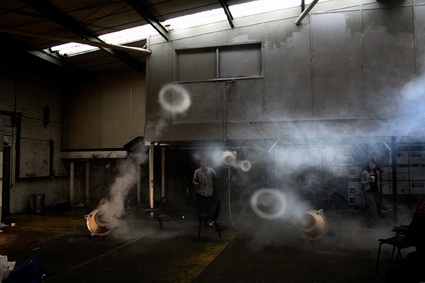 First performance at Old Depot, London, 2011
First performance at Old Depot, London, 2011
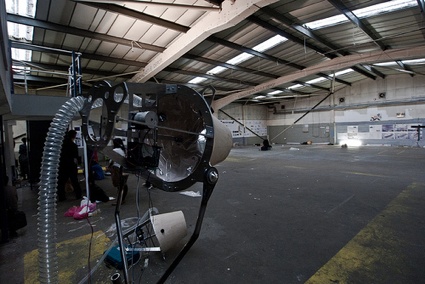 First performance at Old Depot, London, 2011
First performance at Old Depot, London, 2011
Hi Heechen! An Architectural Time Machine ‘creates a series of vortex air and ephemeral scent zone.’ It also looks like a canon to me. How did you build it and how does it work exactly?
An architectural Time Machine project was started as looking at how one sense can be translated into other senses. In particular, there were speculative looks at the possibility that ephemeral and invisible elements such as rhythm, scents and air current could create dynamic and temporal architectural events like musical performance.
AATM create an architectural time-based event as blowing vortex rings with scents to rhythm, they unfold tempo in space. These give observers not only an unfolding spectacular performance of rhythmic vortex rings travelling through space, but also vortex rings and scents from the machines are temporally spatialised and visualized. Observers also can smell different scents from different machines and trace moving vortex rings. When the machines stop their performance blowing vortexes, the formed space gradually vanishes as the space is ventilated.
There is a great and unique mechanism firing vortex rings. The mechanism is electronically auto-controlled. As a mechanism controls the interval of vortex firing time, it brings accurate manipulating a rhythmic beating. To achieve this, I employed an ‘Alternate rectilinear motion’ mechanism, which is given to the rack-rod by continuous revolution of the mutilated spur-gear. Bungee cord in the barrel forces the rod forward to its original position on the teeth of the gear as shown below. As controlling speed of rotation of spur gear, machines achieved rhythmic beating of series of smoke rings.
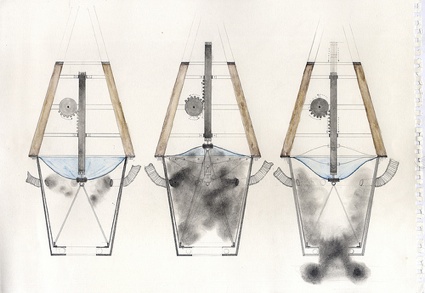 Sketch for vortex firing mechanism, Prototype 02
Sketch for vortex firing mechanism, Prototype 02
A stepper motor, which is mounted on main spur-gear, makes it possible to control the speed of rotation of the main spur-gear releasing the hammer-rod to blow air out. A stepper motor, which converts electrical pulses into discrete mechanical movements, is employed.
The results gathered in a series of experiments led the project to the next step of making the progressed version of the machine. Three different scales of machines were created. Each machine has different abilities of performance due to its scale and power of motor. For instance, each machine performs different travel distances of vortex rings and smoke capacity. These differences could be compared to different scale in musical instruments. The machines are named as Nolan, Van Eyck and Petit Manuel, who are cloud sculptors in J G Ballard‘s short science fiction ‘Cloud sculptor of Coral D’, who shape clouds with their strange glider having cloud-sculpting devices in the wing.
I used CAD/CAM technologies such as laser cutting, SLS, CNC milling etc. Particularly these technologies make it possible to process rapid prototyping. Rapid prototyping by using SLS (Selective Laser Sintering) has already been practiced through my toy project. Rapid prototyping built a 1:5 scale model in order to test and prove a part of the machine before full scale fabricating. Moving mechanisms, sculptural shapes and the body frames of the machine were tested. Then this has led the constructing of 1:1 scale machine.
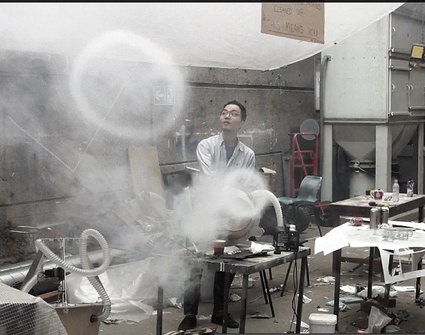 The test of a machine, Van dyck
The test of a machine, Van dyck
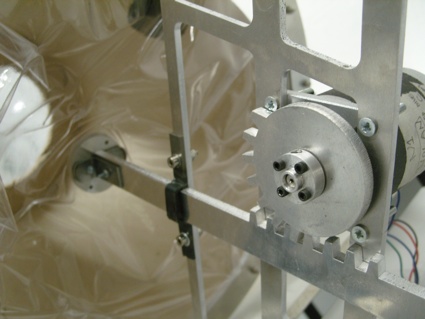 Fabrication for three machines
Fabrication for three machines
The work sounds a bit sci-fi to me. Where did you get the idea for AATM?
You are right. I got an idea from ‘Cloud sculptors in coral D’, J.G. Ballard’s science fiction, in which the three gliders shape clouds with strange machines. I got an idea regarding this project when I was in front of massive loudspeaker in a club. I felt energy of sound from the speaker crashing my body. I thought invisible energy could be translated visible dynamic performance.
But also, I have been very interested in Architectural time based event, looking at how observers can experience time moving in space as observing the performance of machines or devices in space.
Leonardo Da Vinci mentioned ‘tempo’, which referred to ‘speed of time, ‘musical’ or ‘harmonic’ time. It might be easy explanation about AATM that it allows observers to experience ‘tempo’ in space with scents. A series of vortex air from machines construct ephemeral time based event. After travelling through space and time, it just vanishes as space is ventilated.
Here is the best quotation from Stephen Gage in order to help you to understand my inspiration from architectural time based event. “Once we consider architecture to be time based and enmeshed with the way that people perceive and use it, we find ourselves short of reliable conceptual tools that can be used to understand our craft. As an event or series of events in time, we can consider architecture as a performance containing both human and non-human changing protagonists”
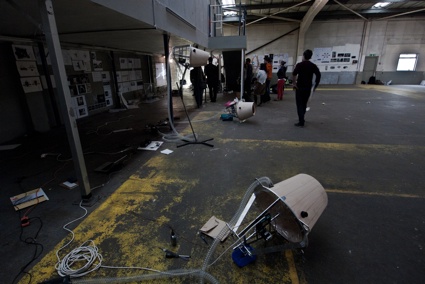 First performance at Old Depot, London, 2011
First performance at Old Depot, London, 2011
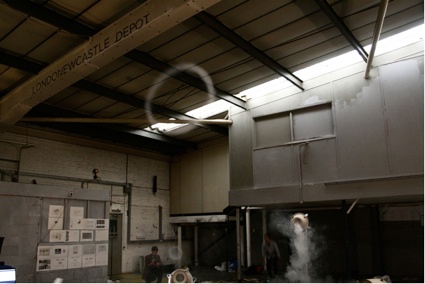 First performance at Old Depot, London, 2011
First performance at Old Depot, London, 2011
The way the vortex rings remain perfectly circular as they rise in the air is impressive. How did you achieve that?
The vortex air generator is an old and traditional toy. It works with simple principles of physics.
Blowing a short puff of air through a circular aperture produces a smoke ring. Amazingly it travels as keeping its shape.
But, on a windy day outside, the machines could not have successfully performed. Strong wind destroys smoke rings immediately when it comes out from a machine. It’s similar to the cloud sculptors of J.G. Ballard who could not perform when dark clouds were coming, which presage rain. However, it could be acceptable as it is the nature of performance, which is temporally affected by weather and site specific conditions.
It’s not rocket science.
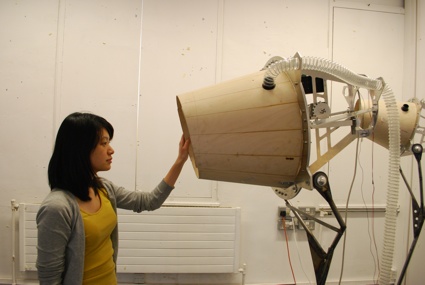 A test for accurate vortex firing
A test for accurate vortex firing
The machine creates scent zones. But what do they smell like? and how/why did you chose that scent?
The idea of putting scent to my machines just came out as a funny idea. I thought my machines could create a funny event to make people smile. For example, I just imagine that when the machine faces a guy, it fires smoke with bacon scent, and if the machine meets a pretty girl, it might fire rings with gentle flower scent.
Basically, my time machines cannot make scent itself, but you can put all the scents you want in it.
When I was developing these machines, I found there are some great potentials with various scents. I came across George William Septimus Piesse, an English chemist and perfumer, who offered a music-inspired taxonomy of scents. Following his music taxonomy of scents, I made scent music cord. For instance, C major cord could be made with Orange flower, Almond and Southernwood scent.
I thought that my 8 machines could play scent music with 8 scents.
Imagine these ridiculous 8 machine play ‘Over the rainbow’ with 8 scents without sound!
You can chose various scent you want to have in various kinds of events, for example, my machines could have a unique event for Chanel’s perfume, such as Chanel’s new perfume launching event. And if you put a specific flavour into my machine, people can breathe and taste smell within the event that my machines create.
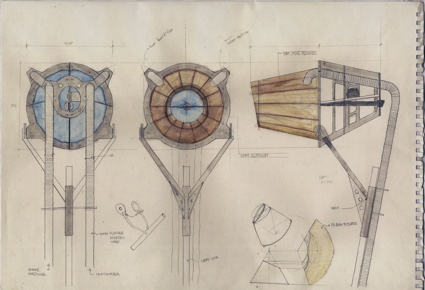 Sketch for final prototype, Petit Manuel
Sketch for final prototype, Petit Manuel
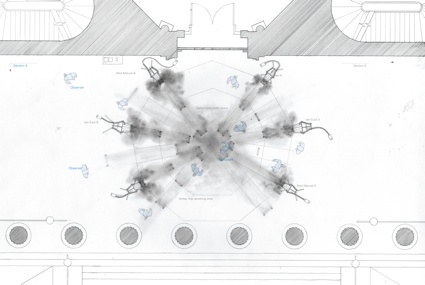 Plan for installation at the Portico, University College London
Plan for installation at the Portico, University College London
Are you planning to develop the work further?
I hope to develop AATM and want to enjoy making various events. I have made six AATMs. It was my Masters project at the Bartlett school of architecture, UCL.
It was definitely an architecture project about architectural time based events and I believe I achieved my aim to set up a theoretical base on my interest through this project at Bartlett. I think it’s time to apply my AATM to various artistic events over architectural theory. I am keen on involving in various events wherever there is a nice atmosphere and fun people to enjoy my machines.
Also I want to have performances in specific places and buildings, which have their own architectural proportions. As AATMs make a proportional rhythm that the building or
place owns by generating vortex air, the rhythm of a building’ proportion can be represented. For example, in a Greek temple, AATM might make rhythmic beating of
Fibonacci series. It might be a fantastic poetic performance in such a historic place.
I enjoy collaborating with Ollie Palmer, a designer of Ant Ballet. We have a plan to have an event next year. It’s going to be really fun!
Any other project you’d like to mention?
At the moment, I have been making a small toy called ‘Inigo’, which is a part of architectural toy project. I have been devised a series of mechanical toys, Toys are printed in one piece by using SLS (Selective Laser Sintering), which allows multiple moving parts to be operated in one piece.
Please visit the web site of Experimental Toy Factory, which I founded last year.
Thanks Heechan!
All images courtesy of Heechan Park.
